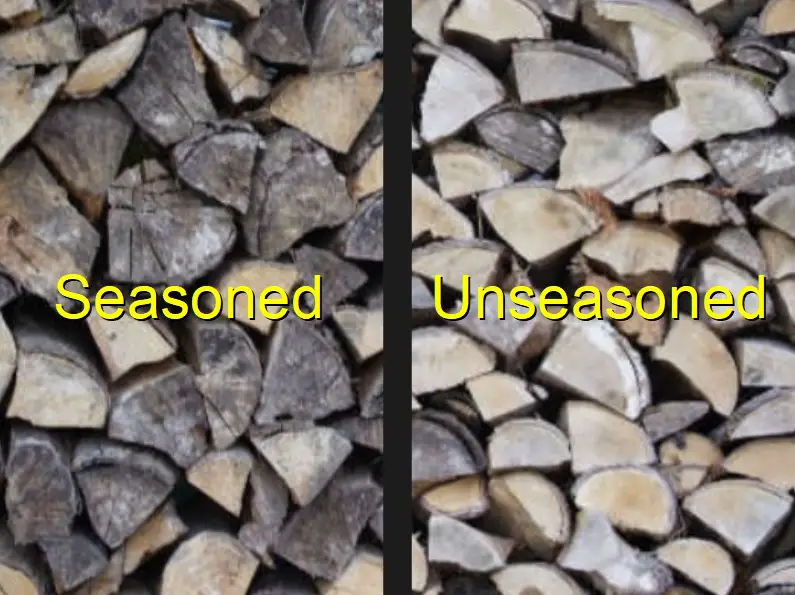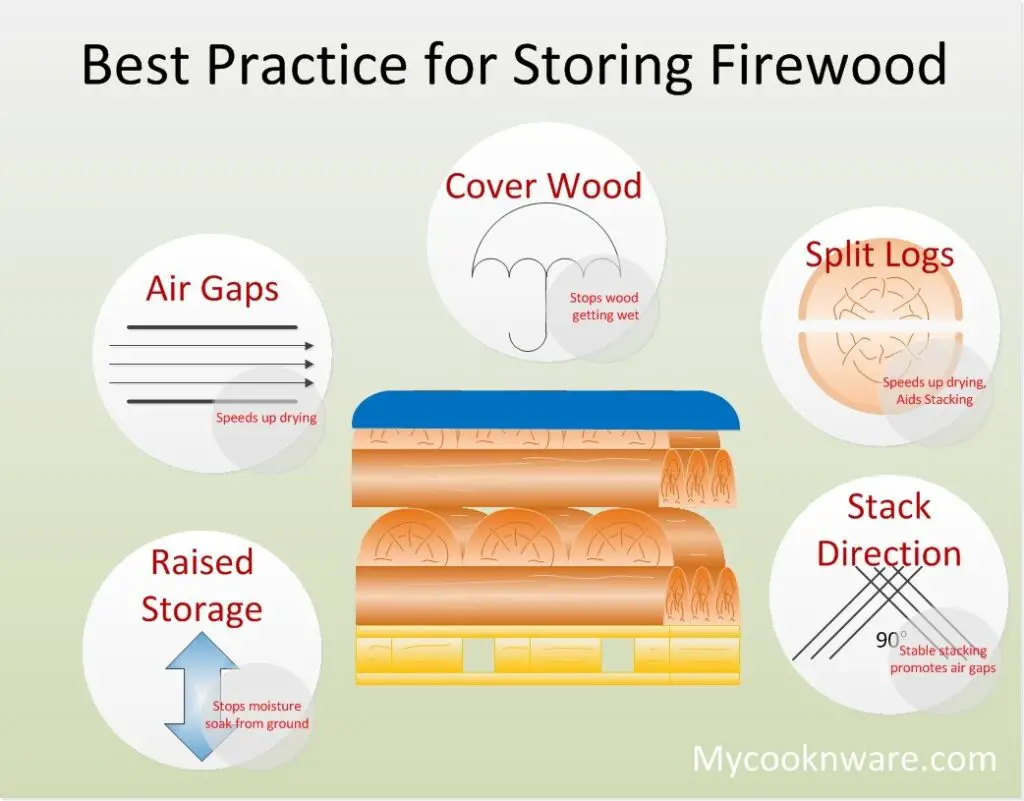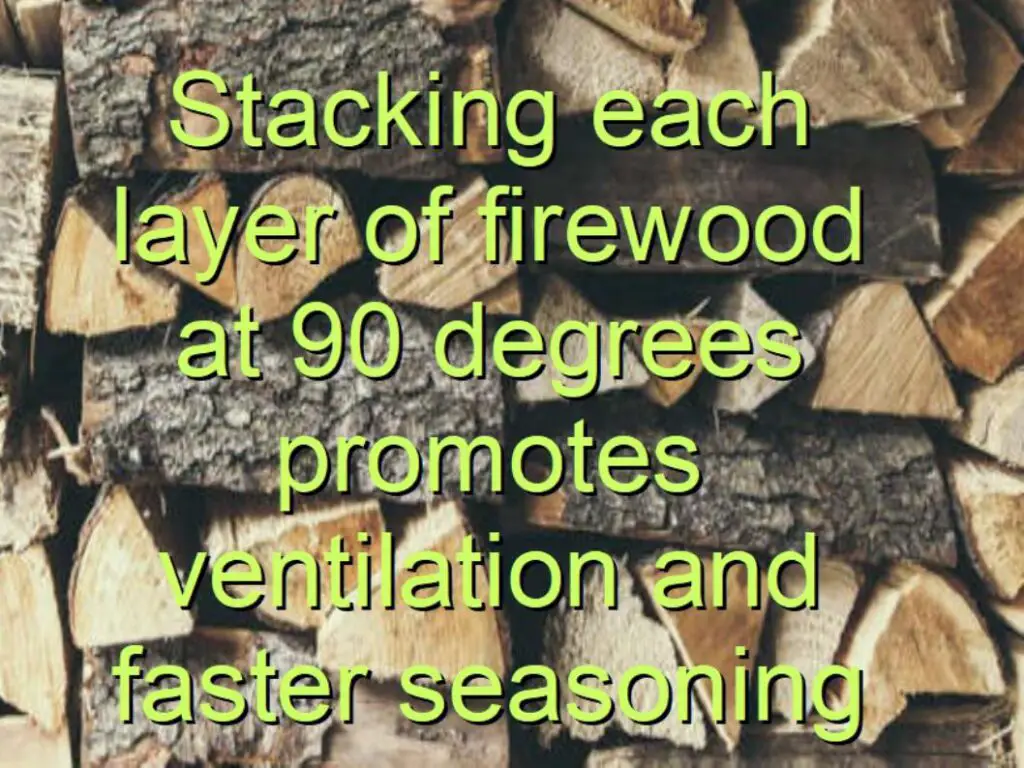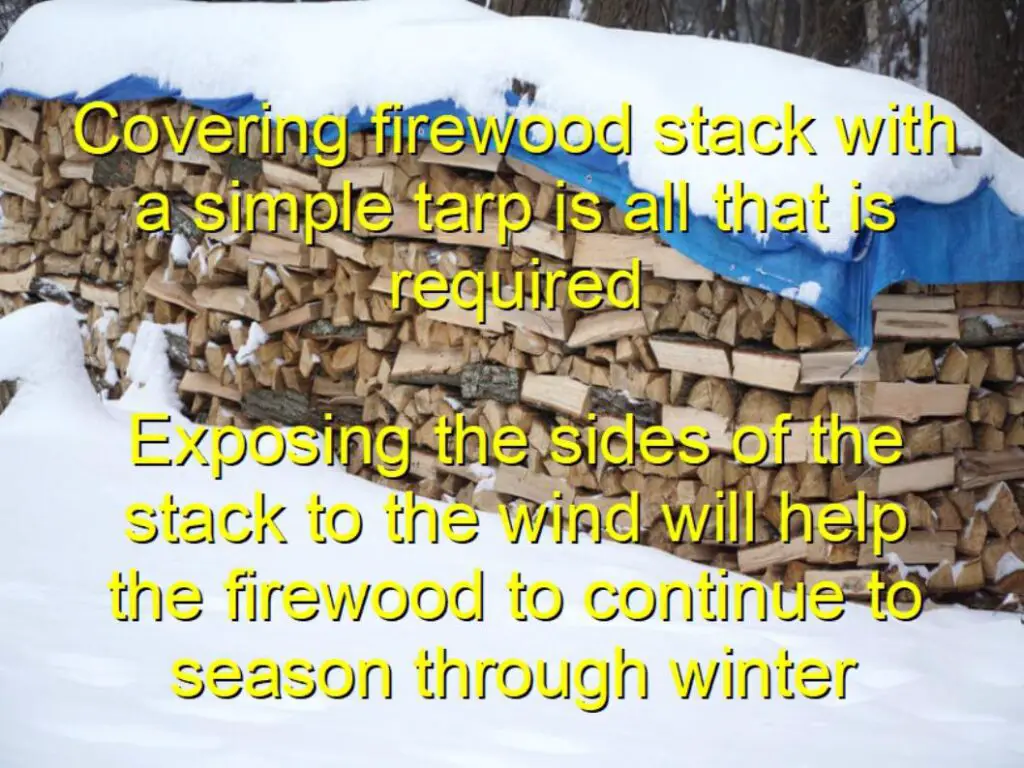Firewood that is unseasoned can be difficult to burn. You should only be burning seasoned firewood in your wood stove.
If winter warming seems like a chore, you’re probably doing it wrong. Unseasoned firewood won’t produce the right amount of heat. Unseasoned firewood pops and crackles, creates too much flue clogging smoke, and that’s if it even catches fire at all.
Today we will cover everything you need to know to get your firewood seasoned as quickly as possible. When winter comes around, you’ll have a roaring fire, trouble-free.
- What is seasoned firewood?
- Why you need to use seasoned firewood
- How to tell if firewood is properly seasoned and ready to burn
- Best practice to prepare firewood for seasoning (drying) in the quickest possible time
- Choose the Right Type of Wood
- Avoid these mistakes when seasoning firewood
- Don’t stack firewood directly on bare earth.
- Don’t stack firewood on a hard stand or any surface without draining or ventilation
- Don’t stack firewood against a solid structure
- Don’t leave it too late to start seasoning your firewood
- Don’t try drying logs that are too large
- Don’t stack firewood logs too tightly together
- Don’t cover the firewood stack in the summer
- Don’t let the firewood get too wet
- Other methods to complete seasoning or even just drying out wet firewood
- How to store seasoned firewood before use
- Seasoning Firewood FAQ
What is seasoned firewood?
Seasoned firewood is wood that has been dried to a point where it contains less than a 20% moisture content.
Why you need to use seasoned firewood
Simply put, unseasoned firewood contains too much moisture. This moisture can be either sap or held as water with-in green wood.
There are many problems with unseasoned firewood, such as;
- Unseasoned firewood is more difficult to catch the light. it will take longer to get a roaring fire going.
- Unseasoned firewood will not burn as well as seasoned firewood. Meaning that your wood stove will not put out as much heat as it should.
- Unseasoned firewood creates more smoke than seasoned firewood. More smoke creates creosote which overtime blocks the flu causing your wood stove to become inefficient. Additionally, creosote is harmful to your health.
How to tell if firewood is properly seasoned and ready to burn
Fortunately, there are a number of ways we can tell if firewood is properly seasoned and ready to burn. We can use our senses to look, feel, hear, and smell. We can test, and lastly we can even use simple technology to double check.
Look
The signs to look for when visually observing if your firewood is properly seasoned are ;
Color.
Typically seasoned firewood has a darker tone than unseasoned firewood.
Bark.
If the bark is separating, splitting, or falling off the logs, this is a good indication the firewood is drying out. If the bark is not falling off, it should at the very least be much easier to remove by hand. If the wood is still green, the bark will peel off in combined strands, and the wood will feel moist underneath the bark.
Cracking.
If the ends of the logs show signs of gaps or cracking this is another good indication the firewood is drying out. Cracking can also occur along the length of the logs.

Feel
Dry.
Properly seasoned firewood will feel dry and hard to the touch. Splinters and fragments will be more difficult to bend. Thin pieces I will snap instead of bending.
Weight.
Seasoned firewood will weigh significantly less than green wood. Depending upon the species of wood, it could be as much as 50% lighter .
Hear
Sound.
The sound difference when banging together two pieces of seasoned firewood versus two pieces of green wood is highly noticeable.
Seasoned firewood will produce a clear, crisp, hollow sound.
Green wood will produce a much duller thudding sound.
Smell
Scent.
Seasoned firewood will still smell like wood, but the scent will be far less noticeable .
Test
Bend
Seasoned firewood is more difficult to bend than green would. When bending, seasoned firewood will snap well before green wood will snap.
Burning
A simple test is to light a fire with kindling created from seasoned firewood. If the kindling catches quickly, with long high flames, the wood is most likely well seasoned, and dry enough to burn.
Technology
Moisture meter
A moisture meter is an electronic device that can quickly & easily read the moisture content of firewood. These devices are typically cheap and affordable, and are a great way to double check if the moisture content is below the ideal moisture content for firewood of less than 20%.
Best practice to prepare firewood for seasoning (drying) in the quickest possible time
The main environmental factors for drying firewood are; temperature, humidity, and ventilation. Controlling the exposure of your firewood stack to these elements will greatly assist in naturally seasoning firewood in the shortest possible time.
The actionable steps involved in seasoning firewood as quickly as possible are;
- Start seasoning firewood as soon as the prevailing weather conditions allow
- Select the right type of wood, that will season in the timeframe before the next winter
- Prepare the wood properly before stacking
- Select the right location for the firewood stack
- Stack the firewood above the bare earth
- Stack layers of firewood at 90 degrees to previous layer
- Dry the firewood in the sun
- Cover the firewood when the cooler months rain arrives

All the tips below will focus on exposing the firewood to these elements for the fastest firewood drying times.
Start seasoning firewood at the right time of year
The best time of year to commence seasoning firewood is a time that will get the wood to the lowest moisture content possible.
A moisture content of less than 20% is generally the target and the recognized determination for “seasoned firewood”. However, continuing to season fire and dry it out further will lead to even better burning results. So there is nothing wrong with giving yourself as much time as possible.
The best time to start seasoning firewood is when the weather starts to turn from winter to spring.
Choose the Right Type of Wood
Where you live will determine what type of wood you have access to. But let’s break this down to cover variables. We’ll think more about hardwood and softwood.
The dense nature of hardwood means that it will typically take longer to dry than most softwoods. The upside of hardwood is that once dry it is superior to softwood for providing warmth.
Conversely, softwood will take less time to season, but will not burn as hot or for as long. Additionally softwood will catch fire more easily than a typical hardwood. Softwood is therefore often a great choice for kindling. While hardwood is the better choice to provide warmth over a long period of time.
We recommend the bulk of any firewood stack to be mostly hardwood, but with a smaller amount of softwood, specifically used for kindling.
Some of the more popular hardwoods to burn that will season quickly are;
- Cherry
- Rock Elm
- Black Locust
- Most fruit trees, Apple, Pear etc.
Preparation – cut and split the wood before stacking
Exposing as much of the wood to the environment is key to seasoning firewood quickly.
This is because the firewood seasons as the water is evaporated out of it. If the ratio of surface area to total moisture content is high, there is a lot of surface area for the moisture content to evaporate from.
In simple terms, the more surface area of each log is exposed to the sun and wind, and the less moisture content held within each log, will equate to faster seasoning. Splitting logs achieves both smaller total moisture content (because the log is physically smaller), and it also increases the exposed surface area (for its size).
The ideal firewood length and split sizes are;
- cut firewood rounds into lengths no more than 75% of what will fit into your wood stove, and
- split the lengths down the middle, 6 – 8 inches around is a good manageable size.
Cutting and splitting the logs, allows for a large surface area to be exposed to sun and wind which will dramatically aid in speeding up the drying time.
Making sure the logs are not cut and split too small is the challenge. Too small and you will be tending your fire too much as each log will burn through too fast.
Select the right location for your firewood stack
The location of a firewood stack will determine how well the firewood is exposed to the drying elements (sun, wind, and humidity).
For clarity, quickly drying firewood naturally is only possible outside. A windy location exposed to fun sun all day is ideal. Typically this will be a high point of the property.
The sun provides warmth to evaporate the moisture contained within the firewood. While the wind, not only has its own drying effect, but helps to push the evaporating moisture (humidity) away from exposed wood.
Stack the firewood away from structures, and do not layer stacks behind each other. The more layers in a stack the less wind will flow through them. If space is an issue, try to leave a small gap between layers, or make the rows higher or longer.
For the same reason, do not stack firewood against a solid structure, like a fence, or side wall of a building.
Prepare the stack
Stack the firewood off the ground.
Stacked firewood should be raised off the ground. Firewood stacked directly onto earth will act like a sponge and soak up moisture through the earth. This is the exact opposite of what you want to happen.
Long logs and better yet, some sort of non porous base or beams are best for the base of a firewood stack. Also, any base should not allow water to pool. A solid base should not be used. Any base must have significant drainage and aeration.

Image source https://www.mtnhp.com/blog/how-to-stack-firewood
Stack each layers at 90 degrees to the previous
Stack each layer of firewood at 90 degrees to the last layer. This is not the most effective use of space but it does mean that there will be larger air gaps between layers, meaning more air flow around each log. More air flow means more ventilation. More ventilation means faster seasoning time.

Manage the firewood stack as the seasons change
Assuming you have selected a firewood that will dry fast enough, and have stacked it properly. The majority of the moisture should be gone by the start of the fall. The next few months are about getting that moisture content don’t as low as possible and keeping it there.
Let the firewood bake in the sun
Leave the firewood stack exposed to direct sunlight and wind throughout spring and summer. This will allow the most exposure of the firewood to the drying element of the sun and wind.
It doesn’t hurt to allow the rain to fall on the firewood stack. Occasional summer rains into early fall are OK. In fact, rain will help flush out and wash away the sap leeches out of the logs. As the rain increases to a few times a week, this would be the signal to cover the top of the firewood stack.
Cover the firewood stack when the weather starts to turn colder
It doesn’t hurt to allow the rain to fall on the firewood stack. It’s OK to allow occasional summer and early fall rains onto the firewood stack. In fact, rain will help flush out and wash away the sap as it leeches out of the logs. As the rain increases to a few times a week, this would be the signal to cover the top of the firewood stack.
Covering the top of the firewood stack will stop consistent rain from water logging logging the wood. Too much rain in the cooler months will slow down the drying process dramatically. So best to avoid over wetting the firewood, once the sun has lost most of its drying power in those cooler months.
You shouldn’t need to cover the sides of the firewood stack. It’s OK for the ends of the firewood to be exposed to the rain. The ends of the firewood logs will dry quickly when the rain stops and the sides of the firewood stack are exposed to the sun and wind again.
Fully covering the firewood stack with a tarpaulin will trap in all the humidity which will be reabsorbed by the firewood. It is almost impossible to dry out firewood in any realistic timeframe if the sides of the firewood stack are covered up.

Image source https://www.firewood-for-life.com/firewood-cover.html
Avoid these mistakes when seasoning firewood
Some common mistakes that are easy to make when seasoning firewood can prolong the drying time.
The more common firewood stacking mistakes are;
- Placing wood directly on the bare earth
- Placing wood on a surface with no draining or ventilation
- Stacking wood against a solid structure
- Start seasoning too late
- Attempting to dry out logs that are too large
- Stacking logs too tightly together
- Covering the firewood
- Exposing firewood to too much water.
Don’t stack firewood directly on bare earth.
Bare earth contains groundwater. Stacking firewood on top of bare earth will cover the earth with shade meaning the sun will not dry the earth. Drying logs will act as a sponge to the moisture contained in the damp soil.
The process of soaking up water will leech up through the log stack. As each log soaks water it will pass that water wherever the logs touch each other.
The firewood must be isolated from constant contact with any form of moisture.
Don’t stack firewood on a hard stand or any surface without draining or ventilation
If rain water becomes trapped at the base of a firewood stack it will leech into the drying firewood quickly. A firewood must be stacked in such a manner that water will fall off then drain away.
Additionally, it is ideal to allow air flow under the base of a firewood stack to help evaporate drying firewood.
Do not place firewood on a hard stand where water can pool, and air cannot circulate.
Don’t stack firewood against a solid structure
Stacking firewood against a solid structure must be avoided.
A solid structure will limit the amount of sunshine a firewood stack receives, and shield it from natural wind flow.
Additionally any bugs or fungus that are housed in the firewood could easily transfer to the structure. If that structure is connected to your house that could be very damaging.
Don’t leave it too late to start seasoning your firewood
You need to start thinking about next season’s firewood as soon as the current burning season is over.
Give yourself the maximum amount of time to dry next season’s firewood.
Drying time of firewood is heavily dependent upon the type of wood, and the environment it is stored. To give yourself the best chance at having low moisture firewood available for the next season, start drying as early as possible.
Don’t try drying logs that are too large
A common mistake is to stack firewood without splitting it first.
The smaller you can cut the wood, the more of its surface is exposed to the elements, and the less moisture it will contain relative to the exposed surface area.
Having more surface area exposed to the sun and wind, while reducing the amount of moisture contained within each log is a critical factor in firewood drying time.
Don’t stack firewood logs too tightly together
Stacking firewood too tightly reduces the amount of sunlight that can penetrate into the logs. It also significantly reduces wind flow in between each log. Reducing wind flow will equal a longer drying time for your firewood.
Best practice is to stack each layer of firewood at 90 degrees to the previous layer. This stops the layers from sinking down into each other, and promotes larger gaps between each log.
Don’t cover the firewood stack in the summer
Covering the firewood stack from the peak drying time of the year is a big mistake.
Seasoning firewood means drying it out. It’s OK for the occasional summer rain to wet the firewood, the sun will soon dry the rain away.
Direct sunlight is needed to bake the firewood dry. Covering the firewood in the summer will slow down the drying process.
Covering the firewood will also limit the wind from blowing through the firewood stack, limiting its evaporating effect.
Don’t let the firewood get too wet
Once the rainy season starts, be quick to cover the top of the firewood stack.
Also be mindful of reticulation. If the firewood stack is frequently exposed to reticulation it will be absorbing this moisture.
If firewood is exposed to reticulation at night, it will have all night to absorb the water. Then the sun will have to work extra hard the following day to extract the water out. If you can’t store the firewood away from sources of reticulation, be mindful to turn it on only when the sun can dry it off quickly, and before any water can soak into the firewood.
Other methods to complete seasoning or even just drying out wet firewood
If you have not managed to fully season your firewood and it is getting too wet each day as winter starts closing in, there may still be some hope.
Here are a few things you can do to speed up the firewood drying time by bringing the firewood inside and;
- Artificially heat the firewood
- Artificially ventilate the firewood
- Dehumidify the firewood storage area.
Both of these methods are described below. For best results use all three methods.
Don’t forget, you still need to stack the firewood off the ground and layer at 90 degrees to each subsequent layer to ensure good ventilation between logs.
Use a kiln to dry out the firewood
When wood dries it tends to change shape, bending with the natural forces and internal stresses contained within its grain structure.
Because of this a lot of wood you buy at the hardware store has been kiln dried. This is usually dressed wood, or wood you would use to fabricate with.
This wood is dried in a commercial process at commercial scale, so not really an option for the home. Although it is possible to buy kiln dried firewood, this is often expensive, and not always available.
You can simulate a kiln if you can manage to heat an enclosed structure and store the firewood inside that structure.
A garage, workshop, or basement is a common place to store firewood. They are also common places to operate wood stoves, particularly double barrel wood stoves as these are cheap to build and put out a lot of heat.
Stacking your firewood inside a heated environment is recommended if you are struggling to complete the seasoning before winter.
This has the added advantage of removing the firewood from outside where the rain might be keeping it wet. It also has the disadvantage of removing it from the wind and preventing natural ventilation. Which brings us to the next point…
Use a fan to dry out the firewood
If you have taken the advice and moved the firewood into a garage of similar housing, you can then set up a fan to blow air through the pile.
Simply place a fan on a high speed to blow air towards (and therefore through the gaps) of the firewood.
The more airflow the better so larger fans will work best here.
Note, that it may not be possible to treat your entire firewood stockpile in this way, but it is possible.
A fan running 24 hours a day should not be a huge drain on an electricity bill.
Dehumidify the firewood
Dehumidifying firewood is a bit trickier than the previous two methods, but again is required to be done within an enclosed building.
A dehumidifier will suck the moisture out of the air within an environment. As the air becomes less humid, and material that contains moisture will have that moisture evaporated from it through its exposed surfaces.
Dehumidifying firewood is another great option. All these options can be used together to get quick results to drying out the last moisture in firewood.
How to store seasoned firewood before use
The above tips can also be used as an intermediary place to store firewood, for a day prior to use. This would require a small space in the garage or workshop to store the firewood to allow it to dry from any water or snow exposure.
Another best practice is to establish a small firewood stack as close to your wood stove as possible. Firewood stored close to the wood stove (while it is on) will dry out quickly.
A wood stove may only be able to dry out that final small amount of moisture over a shorter period of time but every little bit of moisture reduction helps.
Again, make sure the wood is stacked to allow maximum penetration of any available heat and airflow. That means stacking firewood 90 degrees for each layer.
Also when adding more wood to this stockpile, stack new wood at the bottom of the rack. This not only makes it easier to load dryer wood from the top of the stack. But any moisture contained within new wood brought in from outside will not drip through previously dried wood.

